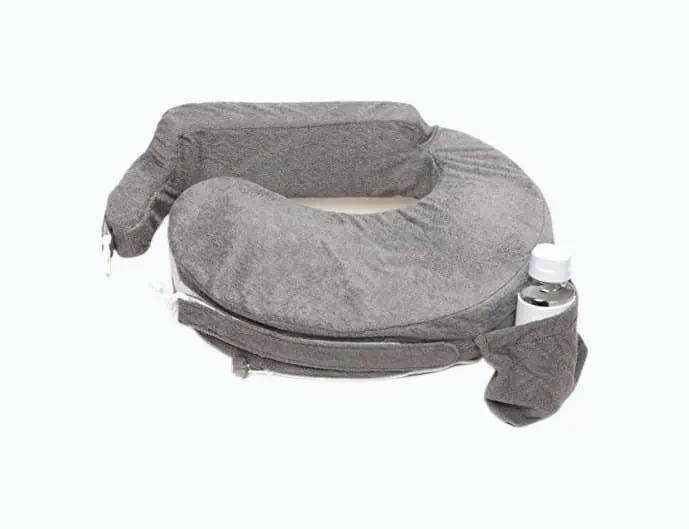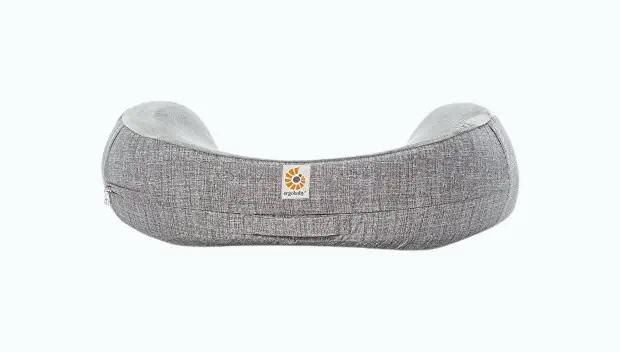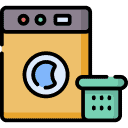Your nursing pillow goes through a lot, with spit up, vomit, poop, leaking breastmilk, and who knows what else. You need this pillow to last at least a few years, but how on earth do you get it clean without ruining it?
After experimenting with a variety of nursing pillow styles and techniques, we’ve found the solution! In this article, we’ll discuss our pro nursing pillow cleaning tips, including the exact steps to clean three common nursing pillows.
Key Takeaways
- To clean a nursing pillow, first check the fabric care instructions.
- Use a gentle, scent-free detergent, safe for your baby and nursing pillow.
- Use a second spin cycle to remove excess moisture before drying.
- Place two tennis balls in a sock in the dryer with your pillow.
- To remove a musty, moldy, or mildew scent from your nursing pillow, add one cup of white vinegar to the main wash.
- Use quality and safe antimicrobial spray when spot-cleaning your nursing pillow, especially if it’s not machine-washable.
- Never soak or fully submerge a non-machine-washable pillow.
Nursing Pillow Cleaning Tips
Whether you have a machine-washable or hand-wash-only nursing pillow, here are some great cleaning tips to follow and some ways to protect your pillow from getting dirty in the first place.
1. Preventative Maintenance:
- Purchase at least two different covers for your pillow so you still have one to use when one is in the wash. We all know how hard it is to keep up with the laundry when you have a newborn.
- Drape a receiving blanket over your pillow while in use to prevent stains. Throwing a receiving blanket in the wash is much easier than having to clean your nursing pillow regularly.
- Wash or spot-clean your nursing pillow every couple of months for preventative maintenance.
2. Washing Machine Tips:
- Always check the fabric care instructions before washing.
- Use a gentle, scent-free detergent, safe for your baby and nursing pillow.
- Use a second spin cycle to remove excess moisture before drying.
- Place two tennis balls in a sock in the dryer with your pillow. This aids the drying process and keeps your pillow’s shape.
- If your nursing pillow is smelly, whether from your baby’s spit-up, puke, or something else, try adding half a cup of baking soda to the main wash to neutralize the odor.
- To remove a musty, moldy, or mildew scent from your nursing pillow, add one cup of white vinegar to the main wash.
3. Spot Cleaning Tips
Use quality and safe antimicrobial spray when spot-cleaning your nursing pillow, especially if it’s not machine-washable. Never soak or fully submerge a non-machine-washable pillow. Here is an all-natural homemade antibacterial spray you can use:
You will need:
- A 20-ounce spray bottle.
- Hot water.
- Washing soda — usually available in the laundry section at your local grocery or department store.
- Antibacterial essential oil.
Take Note
Directions:
- Fill your spray bottle with two cups of hot water.
- Add a quarter cup of washing soda.
- Add five drops of essential oil.
- Shake to dissolve, and spray on affected areas.
Another option for an antimicrobial spray is to fill a spray bottle with half water and half organic, raw, unfiltered apple cider vinegar (ACV). You could also use white, distilled vinegar in place of ACV. We seriously use this for just about all cleaning purposes in our home due to ACV’s antibacterial, antifungal, and antiviral properties.
How To Clean A Nursing Pillow
In this section, we will share step-by-step methods of cleaning three of the most common nursing pillows: the Boppy, the Brest Friend, and the Ergobaby.
Cleaning A Boppy Pillow

- Unzip the slipcover and remove it from your nursing pillow.
- Zip the cover closed before washing to protect the zipper.
- Press out as much air as possible before sticking your pillow in the washer.
- Wash your pillow and slipcover on the delicate cycle with an extra spin and cold water. (If you have a top loader with an agitator, even out the load by adding another pillow.)
- Wrap a sneaker or tennis ball in a pillowcase or sock and throw it in the dryer with your Boppy to keep its shape and get all the excess moisture out.
- Tumble dry the Boppy pillow and slipcover on the gentle cycle with low heat.
- Place the slipcover back on the Boppy after both it and the pillow are fully dry. Cool iron as needed. Do NOT dry clean (2).
Cleaning A Brest Friend Nursing Pillow

The Slipcover
These steps apply to slipcovers for the Brest Friend original, deluxe, twin, and travel nursing pillows.
- Unzip and remove the slipcover from the pillow.
- Zip the slipcover closed before washing to protect the zipper.
- Machine-wash your slipcover in warm water on the delicate cycle. Do NOT use bleach or hot water.
- Hang the slipcover up to air dry.
If you have a professional nursing pillow, wipe the slipcover down with a soft cloth and an antimicrobial spray. Do NOT machine wash.
Inside Cushion
These steps apply to cushions for the original, deluxe, twin, travel, and professional nursing pillows.
- Remove the slipcover and wash according to the instructions listed above.
- With a damp cloth and mild soap or antimicrobial spray, spot-clean the problem areas on your cushion.
- Air-dry the cushion either outside or in a well-ventilated area.
- Place the slipcover back on when both the slipcover and cushion are fully dry.
Foam nursing pillows should never be fully submerged in water or put in the washer or dryer (3).
Cleaning The Ergobaby Natural Curve Pillow

- Remove the cover.
- Zip the cover back up before washing to protect the zipper.
- Machine-wash the cover with cold water on the gentle cycle.
- Tumble dry on low heat.
- Spot-clean the foam cushion by wiping problem areas with warm water and a clean rag.
- Lay the foam cushion flat to dry in a well-ventilated area.
- Once the cushion and cover are dry, replace the cover on the pillow to use it again.
Do NOT iron, dry clean, or use bleach with the Ergobaby Natural Curve Nursing Pillow.










